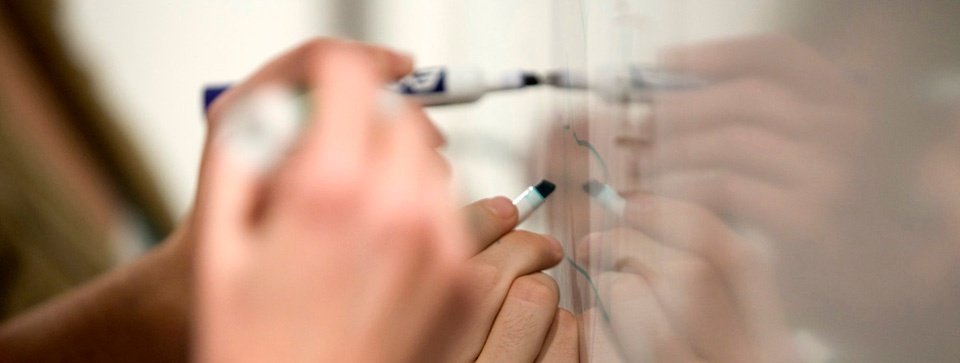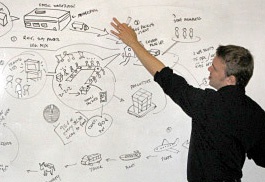
The Designer’s Desk
By Drew Crowley, XPLANE designer
This is the first in a series of tips, tricks and recipes for designers, artists and other visual thinkers working in meetings and other sessions where large amounts of complex information need to be collected and visualized. It’s a peek into how XPLANE approaches discovery and uses visual thinking to communicate key ideas.
Why we do it:
Live sketching gets people engaged in the discovery process and leads to ideas that may not have presented themselves via normal note-taking. The response to visuals being created before a clients’ or colleagues’ eyes is energetic, and that leads to a natural desire to fill in the picture, completely. The result: Understanding and alignment, quickly.
Materials you’ll need:
- Whiteboard or giant stickies
- Variety of small, colorful stickies
- Markers
- Digital camera
 How to do it:
How to do it:
- GET STARTED | Start drawing as soon as you can. The earlier you start drawing in a session the better. It will get the momentum going in the room, the energy level will jump and you’ll start getting real content.
- VISUAL NOTES | The key to live sketching is understanding that it isn’t “drawing” in the traditional sense. It’s visual note-taking. Instead of writing “there was a room with a couch and a lamp,” you draw a couch and a lamp and label it with the word “room.” This simple distinction between drawing and note-taking helps alleviate the fear of drawing in front of people.
- MESSY IS OK | Yes, sloppy is good. The sketches don’t have to be pristine. The sketchier they are the better. By keeping things fast and loose you’re subconsciously telling the audience that these are just notes and not final images. What’s drawn in session isn’t necessarily going to show up in a final XPLANATiON or another visual communication piece. Keeping things sketchy will help drive that point home, and allow everyone to feel like they can add to the pictures themselves.
- ASK | Don’t be afraid to ask for clarification or detail. If things are moving too fast, and you aren’t catching everything, let your partner — or the group — know. If the description doesn’t make sense, ask more questions. If you’re not sure whether you’ve captured something correctly, ask your client or colleague. It’s better to ask and be sure, than to assume you’ve got it and have to fix things later.
- LABEL | Remember that you’re the one that will have to make sense of these notes after the fact, so annotate/sketch/label in a way that makes sense to you. Label people, label scenes, label arrows, label labels! Live sketching can be fast and sloppy, as mentioned above, and the squiggle you draw in a session might make complete sense to you at the time — but two days later it will just be a squiggle. Labels make the difference between a “centralized supply chain database that everyone has access to” and a bunch of mysterious boxes, lines and stick figures.
When you’re done, document everything with a digital camera being careful to avoid window and flash glare on the whiteboards. It’s a good idea to organize and annotate all of the relevant captured info soon after the session.
Live sketching can be done remotely too, using software like Webex or Adobe Acrobat Connect — but that’s a whole other article.
